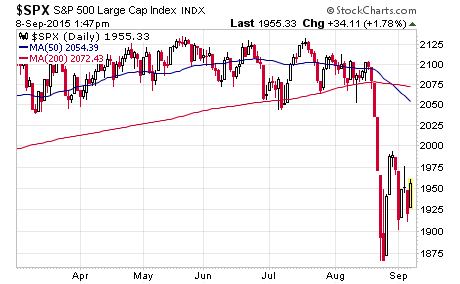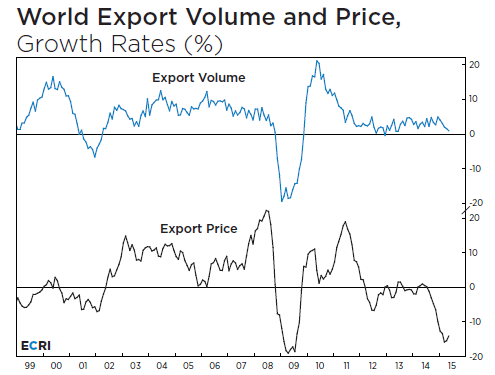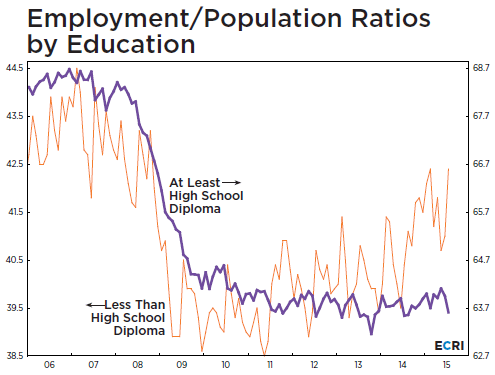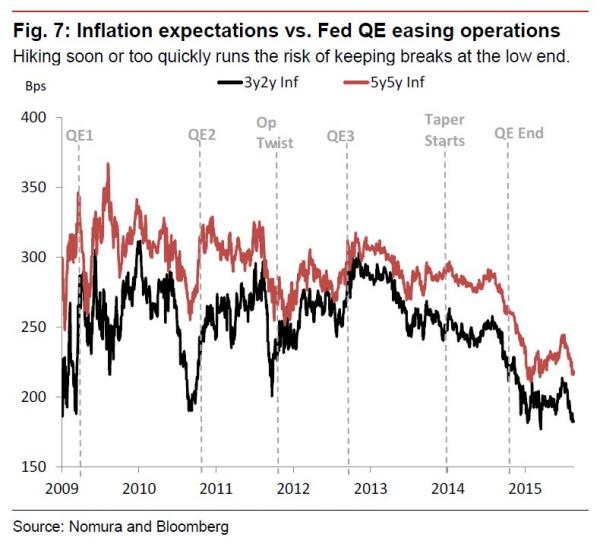
TURBULENCE IS GROWING
September 9, 2015
Last month, I discussed
how risk was rising and that it was time to “fasten your seatbelts” for
increased volatility. That
volatility arrived in August as the chart below of the S&P 500
illustrates.

Starting on August 19th,
the S&P 500 dropped 11% in just four days and the Dow dropped over 2,000
points over the same four days.
So, the question on
everyone’s mind now is whether or not the decline is over.
Let’s highlight a few dynamics in play to see what may be the
likely answer.
First, let’s take a
look at the economic fundamentals.
As we look around the globe, most economies are slowing down, if
not already in recession.
China continues to slow rapidly, the European central bank just lowered
their outlook for the Eurozone, Japan continues to be very weak, Canada
just entered into a recession, most all of the commodity centric
countries continue to slow such as Australia and Brazil and the rest of
Asia is very weak as evidenced by the significant drop in exports from
South Korea.
In the midst of this,
most of the economists here in the U.S. continue to believe that our
economy will not be affected by the global weakness and were encouraged
by the 3%+ reading of 2nd quarter GDP as well as the
employment report last week.
Let’s take a look at global trade and then more squarely on the
U.S. economy.
GLOBAL TRADE CONTINUES TO
WEAKEN…
I highlighted a few
thoughts early in the year by ECRI [Economic Cycle Research Institute]
on global trade and they have recently published an update.
Below are their latest comments.
“After years of
extraordinary policy stimulus around the globe – aimed at pulling demand
forward from the future – world trade growth has collapsed even further
(top line in chart) since we last highlighted it publicly.
Indeed, year-over-year (yoy)
world export growth is now nearing zero.”

“This is happening even
with everything ‘on sale’ as yoy export price growth has plunged deep
into negative territory (bottom line). After
some four years of falling export prices, export price deflation had
become almost as intense as in the depths of the Global Financial Crisis
(GFC).”
“In essence, we have a
shrinking trade pie. Unable to
generate adequate domestic growth, economies are trying to grab a larger
share of that pie through competitive devaluation.
As we observed earlier, this
amounts to war by other means, and all that’s happened recently is that
it’s China’s turn to devalue. “
“As we’ve shown, global
debt has grown to some $200 trillion, with debt-to-GDP ratios having
risen in every major economy. These
debts can be repaid over time either by generating sufficient real
growth to do so; or by inflating away the debts, so that they can be
repaid in currency that is worth much less.”
“But, as ‘the yo-yo
years’ make clear, real GDP growth has been stair-stepping down for
decades in most advanced economies. In
conjunction with the yo-yo years, export prices are exhibiting
increasingly severe deflationary patterns – in both advanced economies
and emerging markets.”
“Under the
circumstances, in the fullness of time, all the major economies are
likely to face a day of reckoning. Though
this journey may well involve a rush to a succession of ‘safe’ assets en
route to that destination, many economies are all effectively circling
the drain.”
“The last time export
price deflation was this intense, not only was Chinese GDP growth even
weaker than it is today, but also every G7 economy was in recession.
It is ominous that the global
trade pie is shrinking so rapidly today – with none of the G7 economies
in recession – yet.” [note:
these comments were as of August 17, before some of the latest global
economic news such as Canada entering a recession and China beginning to
devalue their currency].
GLOBAL ECONOMIC WEAKNESS IS
COMING ONTO OUR SHORES…
Next, let’s look at the
latest leading economic indicator for the U.S. by ECRI [Weekly Leading
Index Growth Rate]. This
index tends to lead the economy by about three to six months.

The chart above shows
their leading indicator dropping notably during the 4th
quarter last year. This
decline gave an indication that economic growth would weaken.
First quarter GDP turned out to be only 0.6%.
Then, ECRI’s leading indicator turned back up sharply during the
1st quarter of this year.
Subsequently, 2nd quarter GDP rose to 3.7%.
Now, their indicator has turned back down and the decline is
getting steeper. If it
continues to anticipate growth here in the U.S., we are likely to see
weakening growth this quarter.
As the global economy has weakened, it looks to be spilling over
onto our shores.
WORDS OF WISDOM…
Now, let’s put the
recent backdrop of economic indicators into a broader perspective with
the help of Ray Dalio from Bridgewater.
He is one of the better macro thinkers and runs the largest hedge
fund in the world. Here are
some of his comments from his latest investor letter.
“That's where we find
ourselves now—i.e., interest rates around the world are at, or near 0%,
spreads are relatively narrow (because asset prices have been pushed up)
and debt levels are high.
As a result, the ability of central banks to ease is limited, at a time
when the risks are more on the downside than the upside and most people
have a dangerous long bias.
Said differently, the risks of the world being at or near the end of its
long-term debt cycle are significant.”
“That is what we are
most focused on. We believe
that is more important than the cyclical influences that the Fed is
apparently paying more attention to.
While we don't know if we have just passed the key turning point,
we think that it should now be apparent that the risks of deflationary
contractions are increasing relative to the risks of inflationary
expansion because of these secular forces.
These long-term debt cycle forces are clearly having big effects
on China, oil producers, and emerging countries which are overly
indebted in dollars and holding a huge amount of dollar assets—at the
same time as the world is holding large leveraged long positions.”
“While, in our opinion,
the Fed has over-emphasized the importance of the ‘cyclical’ (i.e., the
short-term debt/business cycle) and underweighted the importance of the
‘secular’ (i.e., the long-term debt/supercycle), they will react to what
happens. Our risk is that
they could be so committed to their highly advertised tightening path
that it will be difficult for them to change to a significantly easier
path if that should be required.
We believe that the next big Fed move will be to ease (Via QE)
rather than to tighten."
He updated his thoughts
a few days later by saying, “We don’t consider a 25-50 basis point
tightening to be a big tightening.
While we might see a tiny tightening akin to what was experienced
in 1936, we doubt that we will see anything much larger before we see a
major easing via QE.”
I have also quoted
Stanley Druckenmiller many times, as he has been probably the best
investor of our time. He
has been pushing the Fed to get off the zero bound for a while and just
recently came out and said they missed their opportunity and now they
probably won’t raise rates until at least 2017.
As the markets move
through these volatile days, it is easy to get caught up in the trees
and lose sight of the forest.
Dalio and Druckenmiller are two of the best macro thinkers around
and what they are implying by their comments is ominous to say the
least.
Dalio is anticipating
that there is the possibility that the Fed may go ahead and increase
rates in the upcoming meeting but will subsequently reverse course and
start printing money again in a significant way.
I have said recently that either the Fed will not raise in this
month or if they do, it will be later viewed as a policy mistake and I
think Dalio is suggesting a similar scenario.
If they raise rates this month and then we get a weak GDP number
for the 3rd quarter like ECRI is suggesting, the financial
media will be squawking “policy mistake” by the Fed over and over.
That is the near-term
caution by Dalio, but his comments about nearing the end of the
long-term debt cycle has much more implications for a meaningful shift
in one of the more important secular trends regarding global debt.
I have addressed this many times before and will save additional
comments for a later paper.
Nonetheless, Dalio’s comments are worthwhile to think through in the
midst of increasingly short-term attention spans by investors.
To be clear, I was
never in favor of the Fed going to the zero bound in the first place,
much less starting the printing press.
I have said many times that Bernanke led the world down this path
and that the unintended consequences will be very significant.
While many still think he saved the financial system in 2008, I
believe history will ultimately view his policy decisions as going down
a path that led to much greater financial problems and to be the worst
mistakes since the Fed was formed about 100 years ago.
In fact, I think his policy decisions will ultimately lead to the
elimination of the Federal Reserve as we know it and that a much
improved structure based more on market forces will hopefully emerge.
Remember, the current structure is a room full of academics who
have mostly never operated in the private sector setting monetary policy
based on their economic models, forecasts and theories.
Bottom line is that the
Fed has dug themselves deep into a hole and Dalio as well as
Druckenmiller anticipate that rather than starting to climb out, they
are likely to get an even bigger shovel.
That also implies that there are very important developments to
the global economy on the horizon.
To continue this
discussion on the Fed, let’s take a look at some data relating to their
two mandates; maximum employment and price stability [even though they
have dramatically expanded their mandate over the last two decades to
encompass much more than what is outlined in their charter].
First, let’s look more closely at the employment picture.
LOW QUALITY JOBS…
The Fed and other
economists have been pointing to the jobs numbers as one area of
strength in the economy. In
addition to the factors such as the participation rate, part-time
employment and other dynamics that are making the employment picture
seem better than the real situation; there is another interesting
development behind the numbers.
We can use data from ECRI again here to highlight this.
“The sustained decline
in the official jobless rate – now approaching the Fed’s estimate of
‘full employment’ – is a misleading indicator of labor market slack.
Indeed, the stagnation in nominal wage growth is consistent with
the weakness in the employment/population (E/P) ratio.
That said, even the E/P ratio may be overstating the health of
the jobs market.”
“After dropping to
three-decade lows in the wake of the Great Recession, the E/P ratio, has
barely improved since the fall of 2013, reversing only about one-fifth
of its decline from its pre-recession highs.
Furthermore – as a breakdown of the E/P ratio by education level
shows –this modest improvement is illusory.”

“Since 2011, when the
E/P ratio for those with less than a high school diploma bottomed, that
metric has regained almost two-thirds of its recessionary losses (orange
line in chart). But the E/P
ratio for high school or college graduates – i.e., eight out of nine
American adults – has not recovered any of its recessionary losses, and
stands about where it started, one, two and three years ago (purple
line).”
“This data shows that
the so-called jobs recovery has been spearheaded by cheap labor, with
job gains going disproportionately to the least educated — and
lowest-paid — workers. This
is scarcely a good basis for resilient consumer spending driven by
‘solid’ job growth that the consensus – including the Fed – is banking
on.”
INFLATION EXPECTATIONS ON THE
DECLINE…
Now, the second part of
their mandate is price stability.
Here is a chart of market-based expectations of inflation from
Bloomberg. This chart also
lines up the inflation expectations according to the time intervals of
their Quantitative Easing events [QE, or printing money].

You can see by this
chart that the initial round of money printing had the most impact on
inflation expectations and each subsequent round had less and less
impact. Since QE ended,
inflation expectations have weakened further.
Combine the thoughts of
Dalio on the potential ending of the long-term debt super-cycle with the
quality of the jobs market and declining inflation expectations, and you
can start to see why he thinks the next major Fed policy will be another
large round of printing more money.
NEW USES OF MARGIN DEBT…
Now, let’s shift gears
to look at a newer form of margin that investors have pursued.
It is often called “non-purpose loans” which they get from their
financial institutions.
Here is a summary from the Wall Street Journal.
“Loans backed by
investment portfolios have become a booming business for Wall Street
brokerages. Now the bill is
coming due—for both the banks and their clients.
Among the largest firms, Morgan Stanley had $25.3 billion in
securities-based loans outstanding as of June 30, up 37% from a year
earlier. Bank of America,
which owns brokerage firm Merrill Lynch, had $38.6 billion in such loans
outstanding as of the end of June, up 14.2% from the same period last
year. And Wells Fargo & Co.
said last month that its wealth unit saw average loans, including these
loans and traditional margin loans, jump 16% to $59.3 billion from last
year.”
“In a securities-based
loan, the customer pledges all or part of a portfolio of stocks, bonds,
mutual funds and/or other securities as collateral.
But unlike traditional margin loans, in which the client uses the
credit to buy more securities, the borrowing is for other purchases such
as real estate, a boat or education.
Securities-based loans surged in the years after the financial
crisis as banks retreated from home-equity and other consumer loans.
Amid a year’s long bull market for stocks, the loans offered
something for everyone in the equation: Clients kept their portfolios
intact, financial advisers continued getting fees based on those assets
and banks collected interest revenue from the loans.”
So, investors have now
essentially used margin loans not only for buying more stocks but also
to support their spending habits [i.e., buying real estate and boats].
Traditional margin debt is used to buy liquid securities so if
margin calls come from declining security prices, either the investor or
the financial institution can sell down their loan balance immediately
because stocks can be sold daily.
Now, think through what happens when the loans are used to buy
illiquid assets such as real estate and boats and a margin call comes in
as a result from declining stock prices.
As the clients will struggle to get liquid on the assets
purchased with the loans, there will be ever increasing pressure to
liquidate much more from their stock portfolios.
This is just yet another example of the ongoing speculation due
in large part to profligate monetary policies.
CAUTION FLAGS ARE STILL OUT…
Let’s close for this
month. In August, the
market broke down out of the tight range it had been in the whole year
with a very sharp initial move lower.
We are now seeing a bounce off short-term oversold conditions.
The bounce may go a little further in price but it is likely to
end relatively soon in time and roll back over and break below the lows
in August. The longer-term
structural issues continue to build and we may be closer to an important
inflection point if Dalio is correct.
For now, keep your seatbelts fastened as more turbulence is to
come.
Joseph R. Gregory, Jr.